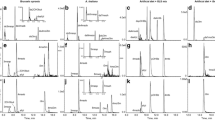Summary
Samples of sieve-tube sap were obtained as honeydew from aphids feeding on three species of higher plants. The honeydew was extracted, chromatographed and tested in several bioassays for the presence of gibberellin-like substances. The bioassay results indicated that gibberellin-like substances were translocated in the phloem of dandelion (Taraxacum officinale), broad bean (Vicia faba) and willow (Salix viminalis). Results obtained with willow showed that the concentration of gibberellin-like substances in the sieve-tube sap is daylength dependent, high levels being present in plants maintained under long days and low levels in short day plants.
Similar content being viewed by others
References
Biddulph, O., S. Biddulph, R. Cory and H. Koontz: Circulation patterns for phosphorus, sulphur and calcium in bean plants. Plant Physiol 33, 293–300 (1958).
Brian, P. W., and H. G. Hemming: The effects of gibberellic acid on shoot growth of pea seedlings. Physiol. Plant. 8, 669–681 (1955).
Carlisle, D. D., D. J. Osborne, P. E. Ellis, and J. E. Moorhouse: Reciprocal effects of insects and plant-growth substances. Nature (Lond.) 200, 1230 (1963).
Carr, D. J., D. M. Read, and K. G. M. Skene: The supply of gibberellins from the root to the shoot. Planta (Berl.) 63, 382–392 (1964).
Chin, T. Y., and J. A. Lockhart: Translocation of applied gibberellin in bean seedlings. Amer. J. Bot. 52, 828–833 (1965).
Eagles, C. F., and P. F. Wareing: The role of growth substances in the regulation of bud dormancy. Physiol. Plant. 17, 697–709 (1964).
Frankland, B., and P. F. Wareing: The effects of gibberellic acid on hypocotyl growth of lettuce seedlings. Nature (Lond.) 185, 255–256 (1960).
Hill, G. P.: Exudation from aphid stylets during the period from dormancy to bud break in Tilia americana. J. exp. Bot. 13, 144–145 (1962).
Hoad, G. V.: (+)-Abscisin II[(+)-dormin] in phloem exudate of willow. Life Sci. 6, 1113–1118 (1967).
—, and A. J. Peel: Studies on the movement of solutes between the sieve tubes and surrounding tissue in willow. I. Interference between solutes and rate of translocation measurements. J. exp. Bot. 16, 433–451 (1965).
——: Studies on the movement of solutes between sieve tubes and surrounding tissues in willow. II. Pathways of ion transport from the xylem to the phloem. J. exp. Bot. 16, 742–758 (1965).
Jones, R. L., and I. D. J. Phillips: Organs of gibberellin biosynthesis in light-grown sunflower plants. Plant Physiol. 41, 1381–1386 (1966).
Kennedy, J. S., and T. E. Mittler: A method of obtaining phloem sap via mouth parts of aphids. Nature (Lond.) 171, 528 (1953).
Kluge, M., E. Reinhard, u. H. Ziegler: Gibberellinaktivität von Siebröhrensäften. Naturwissenschaften 6, 145–146 (1964).
Kollmann, R., u. I. Dorr: Lokalisierung funktionstüchtiger Siebzellen bei Juniperus communis mit Hilfe von aphiden. Z. Pflanzenphys. 55, 131–141 (1966).
Link, G. K. K., V. Eggers, and J. E. Noulton: Avena coleoptile assay of ether extracts of aphids and their hosts. Bot. Gaz. 101, 928–939 (1940).
Lockhart, J. A.: Studies on the organ of production of the natural gibberellin factor in higher plants. Plant Physiol. 32, 204–207 (1957).
MacMillan, J., and P. J. Suter: Thin layer chromatography of the gibberellins. Nature (Lond.) 197, 790 (1963).
Maxwell, F. G., and R. H. Painter: Auxin content of extracts of certain toler nt and susceptible host plants of Toxoptera graminum, Macrosiphum pisi and Therioaphis maculata and relation to host plant resistance. J. econ. Entomol. 55, 46–56 (1962a).
——: Auxins in honeydew of Toxoptera graminum, Therioaphis maculata and Macrosiphum pisi and their relation to degree of tolerance in host plants. Ann. entomol. Soc. Amer. 55, 229–233 (1962b).
McComb, A. J.: The stability and movement of gibberellic acid in pea seedlings. Ann. Bot., N. S. 28, 669–687 (1964).
Michniewicz, M.: Biologiezna metoda ilosciowego oznaczania kwasa giberelinowego testem pierwszegoliscia owsa. Acta Soc. Bot. Polon. 30, 553–568 (1961).
Paleg, L. G.: Physiological effects of gibberellins. Ann. Rev. Plant Physiol. 16, 291–322 (1965).
Peel, A. J.: The movement of ions from the xylem solution into the sieve tubes of willow. J. exp. Bot. 14, 438–447 (1963).
Phillips, I. D. J.: Root-shoot hormone relations. I. The importance of an aerated root system in the regulation of growth hormone levels in Helianthus annus. Ann. Bot., N. S. 28, 17–35 (1964a).
—: Root-shoot hormone relations. II. Changes in endogenous auxin concentration produced by flooding of the root system in Helianthus annus. Ann. Bot., N. S. 28, 36–45 (1964b).
—, and R. L. Jones: Gibberellin-like activity in bleeding sap of root systems of Helianthus annus detected by a new dwarf pea epicotyl assay and other mmethods. Plants 63, 269–278 (1964).
Swanson, C. A.: Translocation of organic solutes. In: Plant physiology, F. C. Steward (ed.), p. 481–545, New York: Academic Press Inc. 1959.
Thomas, T. H., P. F. Wareing, and P. M. Robinson: Action of the sycamore ‘Dormin’ as a gibberellin antagonist. Nature (Lond.) 205, 1269–1272 (1965).
Weatherley, P. E., A. J. Peel, and G. P. Hill: The physiology of the sieve tube. J. exp. Bot. 10, 1–16 (1959).
Whyte, P., and L. C. Luckwill: A sensitive bioassay for gibberellins based on retardation of leaf senescence in Rumex obtusifolius. Nature (Lond.) 210, 1360 (1966).
Woolley, J. T., T. C. Broyer, and G. V. Johnson: Movement of chlorine in plants. Plant Physiol. 33, 1–7 (1958).
Ziegler, H.: Untersuchungen über die Leitung und Sekretion der Assimilate. Planta (Berl.) 47, 447–500 (1956).
Zimmermann, M. H.: Translocation of organic substances in trees. II. On the translocation mechanism in the phloem of white ash Fraxinus americana. Plant Physiol. 32, 399–404 (1957).
—: Absorption and translocation: Transport in the phloem. Ann. Rev. Plant Physiol. 11, 167–190 (1960).
Zweig, G., S. Yamaguchi, and G. W. Mason: Translocation of C14-gibberellin in Red Kidney Bean, normal corn and dwarf corn. Advanc. in Chem. series 28, 122–134 (1961).
Author information
Authors and Affiliations
Rights and permissions
About this article
Cite this article
Hoad, G.V., Bowen, M.R. Evidence for gibberellin-like substances in phloem exudate of higher plants. Planta 82, 22–32 (1968). https://doi.org/10.1007/BF00384695
Received:
Issue Date:
DOI: https://doi.org/10.1007/BF00384695




